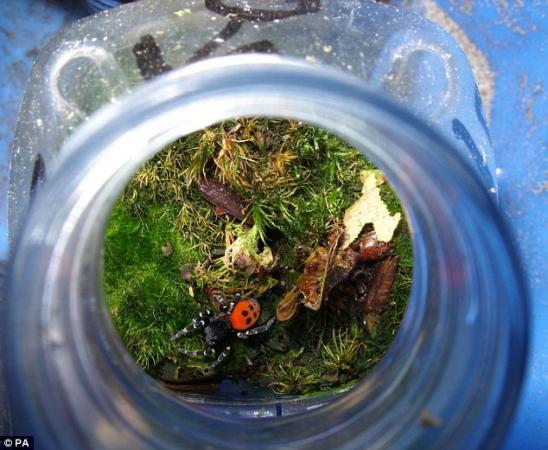北京时间8月12日消息,近日,英国正将一种罕见的本地蜘蛛重新引入它位于多塞特郡的一些原始栖息地。这种蜘蛛叫做草隆头蛛,人们一度担心这种蜘蛛即将从英国灭绝,但是最近它们的数量出现了回升。本周四,科学家们开始尝试将这些蜘蛛重新引入它们的原始栖息地,希望它们能重新在野外灌木丛中安家。
保护专家们发现让蜘蛛们尽快适应新环境的办法是借助一些空瓶子,这可以让蜘蛛们在里面安家。
草隆头蛛的英文名字意为“瓢虫蜘蛛”,之所以有这样的名字是因为成熟的雄性蜘蛛拥有漂亮的亮红色和黑色斑纹,就和瓢虫一样。这种蜘蛛极其稀有,并且行踪隐秘,大部分时间它们都穴居于地下。
根据统计,1994年时全英国仅有一处地点发现了草隆头蛛。而进一步对于它们蛛网数量的统计则显示这里仅生活着大约56只草隆头蛛。但是在采取有力的保护措施之后,这种蜘蛛的种群数量开始有了显著的回升,现在它们的数量已经超过1000只。英国政府采取的保护措施包括人工繁育,野外放生以及栖息地恢复保护等工作。
尽管采取了如此多方面的举措,这种蜘蛛仍然仅仅存在于多塞特郡的少数几处地点。因此这次科学家们决定帮助它们开辟新的栖息地,以便更好地扩展其种群数量。现在这片新栖息地已经有240只草隆头蛛前来安家了。
保护区管理员托比·布莱斯顿(Toby Branston)说:“能在这里引入这样一种珍稀的蜘蛛非常让人兴奋,我希望我们能帮助它们进一步增加种群数量。”
这些蜘蛛是在另一处栖息地捕捉的,之后它们被放进空的矿泉水瓶子里,这些瓶子中事先塞进了石南花和苔藓。研究人员们认为这些空瓶子的尺寸和形状都非常适合给这些蜘蛛们当做新家使用。保护小组将在新栖息地挖洞,将这些空瓶子放进去,他们希望蜘蛛们能看的中这里,并最终在这片石南丛中安家。
生物探索推荐英文论文摘要:
Back from the brink: Rare ladybird spiders reintroduced into UK countryside
An incredibly rare species of spider that has been brought back from the brink of extinction is set to be reintroduced in at a nature reserve in Dorset - with a little help from household waste.
There were just 56 individuals ladybird spiders on one site in the county by 1994.
Since then, work to preserve its habitat and a programme of captive breeding and relocations to suitable heathland areas in the county have helped boost numbers to more than 1,000.

Black and red: The rare ladybird spider is being moved to a nature reserve after a breeding programme that helped raise its numbers following a brush with extinction
Even so, the spiders are still only found at a few sites in Dorset. But today a new colony is being moved to a species-rich heathland reserve.
And conservationists have found that the best way to transfer them to their new home is to make temporary burrows for the spiders out of empty water bottles.
In the latest move, endangered ladybird spiders - so called because of the bright red and black markings on the male during mating season - are being transferred to the RSPB's Arne reserve, one of the most diverse insect and spider habitats in the country.
The heathland site is already home to 240 species of spider and hundreds of insects, including the rare silver studded blue butterfly, the Purbeck mason wasp, which is found only in Dorset, and the Roesel's bush cricket, discovered there last year.
The small ladybird spiders spend most of their life underground, living a solitary existence in silk-lined burrows with a web over the entrance.
They catch a range of large beetles, bees and wasps in their webs and drag them underground, but can also leave the burrow and chase after prey.

At home: The ladybird spiders are being transported in old jars, which make perfect habitats for the creatures on their way to the RSPB's Arne reserve in Dorset
Toby Branston, warden at RSPB Arne, said: 'Arne is an amazing place for bugs and this is the best time of year to see and hear them.
'To be introducing such a rare new species here is very exciting and I hope we can help it to spread further.
'Burying plastic bottles in the heathland may seem a little strange to some of our visitors but the experts have found that this is the best way to translocate the spiders.
'This is an ideal habitat for them, so we will be keeping a close eye on the new colony and carrying out regular surveys to see if they take to their new home.'
The spider has suffered from the loss of lowland heath habitat, 90 per cent of which has vanished in face of development of towns and conversion to conifer forest or agricultural land, the RSPB said.
Remaining areas of heathland have become fragmented or ceased to be properly managed, leading to the growth of scrub and threatening species such as sand lizards and nightjars.







